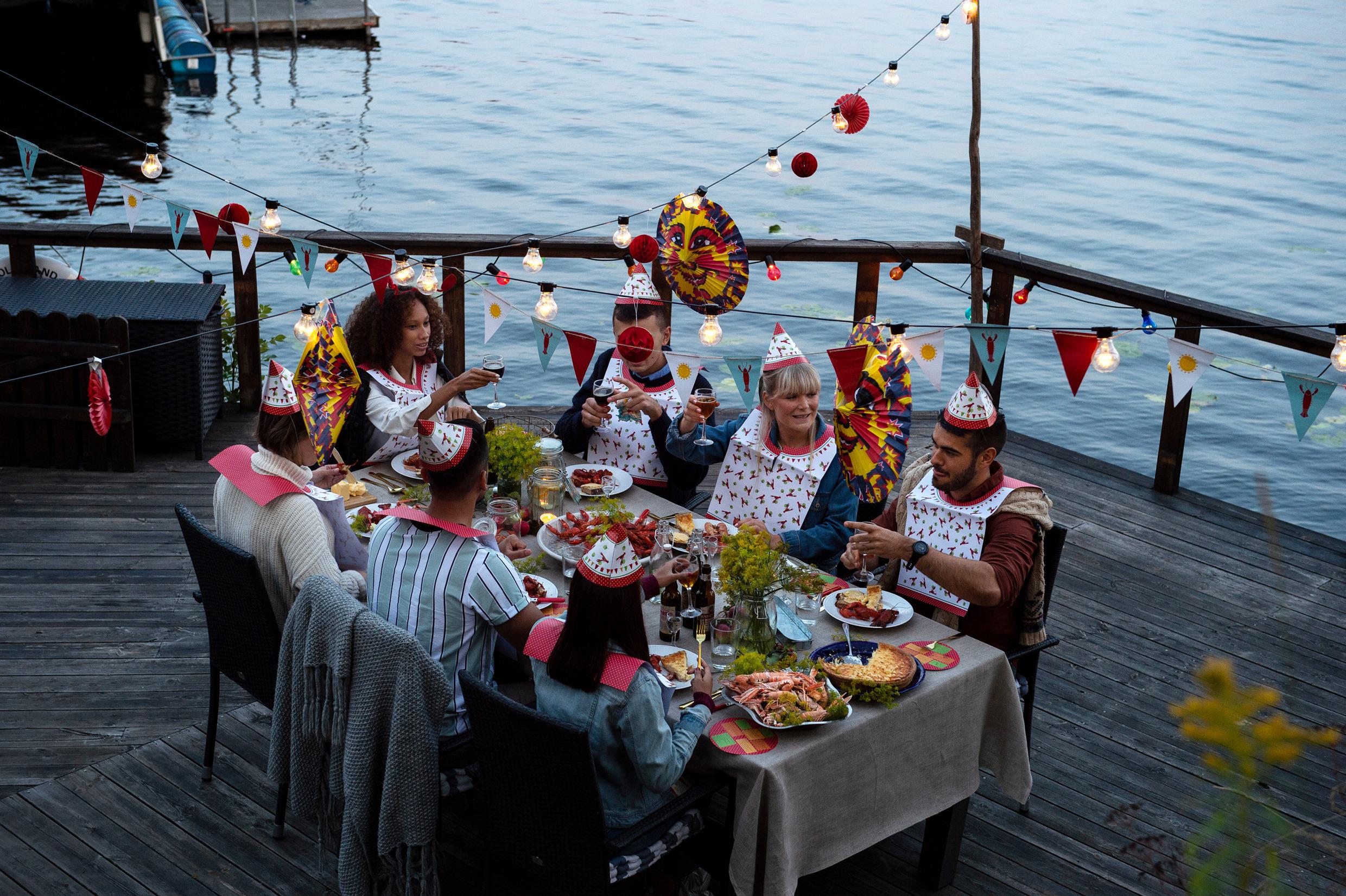
Experience a Swedish crayfish party
Sweden has many unique traditions, the crayfish party being just one of them. Join in to absorb a slice of true Swedish cultural heritage.

Sweden has many unique traditions, the crayfish party being just one of them. Join in to absorb a slice of true Swedish cultural heritage.
A highlight on the Swedish calendar, the ‘kräftskiva’ (crayfish party) – an annual seafood fest with lots of side dishes, drinks and joyous songs – is a summertime celebration dear to Swedes of all ages. Its history stretches back to as early as the 16th century, when it became popular with the royals. In the 17th century, Swedes started eating crayfish on a broader scale. The name kräftskiva was coined in the 1930s and it’s believed to derive from the 19th century bourgeois crayfish ritual ‘kräftsupa’ – involving crayfish and alcoholic drinks. As for the kräftskiva as we know it today, it took off in earnest in the 1960s.
The kräftskiva season kicks off at the beginning of August and usually runs well into September. Nowadays, no specific date is set, although traditionally the crayfish party season began on the first Wednesday of August, reflecting the historic ban on crayfish fishing between November and August 7. Most crayfish parties take place outdoors, making the most out of the last summer days. If you want to experience a classic Swedish tradition, this is the best time to visit Sweden.
Crayfish parties are an annual tradition in Sweden where people come together to eat crayfish and to spend time together. The crayfish parties normally take place in August and mark an end to summer.
Photo: Anna Hållams/imagebank.sweden.se

Photo: Anna Hållams/imagebank.sweden.se

Photo: Anna Hållams/imagebank.sweden.se

Photo: Anna Hållams/imagebank.sweden.se
The crayfish could be described as a mini lobster and it tastes similar, with deliciously succulent meat. Swedish ones are particularly sought-after. Freshwater varieties (‘signalkräfta’ and ‘flodkräfta’) thrive in lakes and rivers across Sweden, while the longer-bodied langoustine (‘havskräfta’) is found in the sea and is caught on the west coast, so there are slightly regional differences.
Crayfish are nocturnal and caught in netted pots baited with small fish at night. A fishing licence is required, and even if you hold one there are restrictions. In Sweden, the public can only fish for crayfish in Lake Vättern and since January 2020 crayfishing in Vättern is only allowed on three consecutive weekends, instead of the previously permitted five weekends. The three weekends start on the fourth Friday in August. During these three weekends only, you do not need a fishing licence.
But fret not – Swedish crayfish are available in supermarkets and at fishmongers. To meet the huge demand and prevent crayfish depletion in Swedish waters, the shellfish is imported from China, Turkey and the US – territories in which the delicacy is also eaten on a wider scale. Cooked in water, salt and sugar, often laced with ale and always with plenty of crown dill, the crayfish turns from black to red when cooked. Eaten cold and piled high on large platters, they make for a visual feast.
The tradition of kräftskiva has been part of Swedish culture for some 100 years, and it’s not all about bright red crayfish. It brings people together and can take many shapes, from cosy family gatherings to more hedonistic parties, lasting well into the night. It’s common that guests contribute with side dishes, like a salad, a pie or freshly baked bread. In Sweden, we call this communal custom ‘knytkalas’, or ‘knytis’.

So what are the essential ingredients of this August feast, aside from the star ingredient itself? Creamed chanterelle on toast is a favourite, so too is freshly baked bread, topped with butter and slices of ‘Västerbottenost’ – a delicious cheese made in the Västerbotten province on the northeast coast. A quiche made from this cheese is another kräftskiva staple.
To drink, expect beer and ‘snaps’ –flavoured shots of aquavit. The ceremonial downing of these is accompanied by song. ‘Helan Går’ is the most famous kräftskiva tune.
Moving with the times, this traditional celebration has evolved. Today it also includes vegetarian and vegan options, such as artichoke (which is eaten in a similar way as a crayfish), tofu in brine and tomato quiche. In line with the Swedish culinary scene’s increased focus on sustainability, organic produce and locally sourced ingredients take centre stage.
Crayfish parties are an annual tradition in Sweden where people come together to eat crayfish and to spend time together. The crayfish parties normally take place in August and mark an end to summer.
Photo: Anna Hållams/imagebank.sweden.se

Photo: Anna Hållams/imagebank.sweden.se

Photo: Anders Ekholm/Folio/imagebank.sweden.se

Photo: Tina Stafrén/imagebank.sweden.se

Photo: Tina Stafrén/imagebank.sweden.se
The crayfish party is a custom with certain quirks. Novelty paper hats are worn, and tables are typically adorned with crayfish-themed décor.
As for the consuming of the delicious crustacean, turn it belly up and suck the brine – slurping is almost mandatory; no need to be polite. Next, wring off the tail and extract the most sought-after part of the crayfish meat using a crayfish knife, then lift the back shield to reveal the delicious “crayfish butter” – a yellowish, butter-like paste found behind the head. The claws are best cracked with a crayfish knife, and the succulent meat can be teased out with a designated, pronged tool – though you’ll manage fine with a fork or your bare hands.
Make sure you have napkins and a finger bowl of lemony water by your side. A bib is not a bad idea either. A kräftskiva is a wonderful, but somewhat messy affair – a party you’ll never forget.